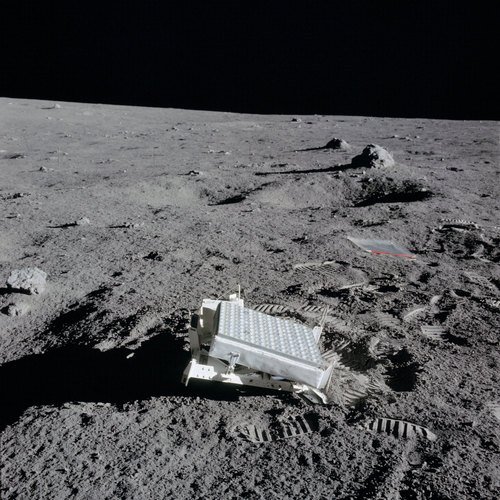The reason we’re shooting laser beams between Earth and the moon

For the first time ever, scientists received a signal after sending laser beams from Earth to a reflector on NASA’s Lunar Reconnaissance Orbiter around the moon.
The successful signal was received after multiple attempts over the last decade, and the results of the study could complement future laser experiments used to study space.
A laser station in Grasse, France, sent the laser beams toward the NASA orbiter, some 240,000 miles away. The beams had to travel that distance to hit a reflector on the orbiter that was only about the size of a paperback novel.
The study published last week in the journal Earth, Planets and Space.
The orbiter has been observing the moon since 2009, and its reflector is a smaller version of reflector panels placed on the lunar surface during the Apollo 11, 14 and 15 landings on the moon. Soviet lunar robotic landers sent in 1970 and 1973 also carried smaller reflectors.
Together, these reflectors are the last working science experiment from the Apollo era, according to NASA. Each one contains cubes created from the corners of glass cubes that act like mirrors reflecting back light in a multidirectional way.
But the older, larger reflectors on the lunar surface are sending weak signals, returning only about a tenth of what they expected. Scientists believe that it may be due to dust that has collected on the five panels.
Micrometeorites impact the moon all of the time, sending up dust that then settles back down. Dust could not only block light from the mirrors, but actually act as an insulating layer that causes the reflectors to overheat.
Testing the signal strength of the pristine reflector on the orbiter can help scientists determine what’s happening with the reflectors on the surface. So far, the science team isn’t sure if it’s dust. But this successful signal is a start to learning what’s happening on the moon’s reflectors.
What lasers tell us about the moon
Since the Apollo era of exploring and landing on the moon, scientists have been using reflectors to understand our lunar companion.
By simply aiming light at the reflectors, scientists measured how long it took light to travel back from the moon to the Earth. This revealed that Earth and the moon are actually drifting apart over time, about 1.5 inches per year, caused by the way they interact gravitationally with each other.
“Now that we’ve been collecting data for 50 years, we can see trends that we wouldn’t have been able to see otherwise,” said Erwan Mazarico, study author and a planetary scientist from NASA’s Goddard Space Flight Center in Greenbelt, Maryland, in a statement. “Laser-ranging science is a long game.”
Scientists have also discovered a slight, telltale wobble as the moon rotates, which suggests that it has a fluid core. But is there a solid core within that fluid? Scientists don’t know yet.
“Knowing about the Moon’s interior has bigger implications that involve the evolution of the Moon and explaining the timing of its magnetic field and how it died out,” said Vishnu Viswanathan in a statement, a NASA Goddard scientist who studies the internal structure of the moon.
When Apollo astronauts returned samples from the moon back to Earth, they revealed that the moon once had a magnetic field billions of years ago — that doesn’t exist today. This has intrigued scientists because they want to know what caused the moon to have one in the first place.
Laser science could determine if the moon has a solid core, which could have provided that magnetic field. However, that will require more accurate lasers to measure the distance between Earth’s laser stations and reflectors on the moon.
“The precision of this one measurement has the potential to refine our understanding of gravity and the evolution of the solar system,” said Xiaoli Sun, a planetary scientist at Goddard who helped design the orbiter’s reflector, in a statement.
The challenges of laser experiments
Targeting the reflectors on the moon may sound simple, but it means tracking them down to their specific locations as the moon is moving in orbit.
Particles called photons in the lasers can also be scattered as they travel to and from the moon through Earth’s thick atmosphere. So a 10-feet-wide laser beam leaving Earth can become a mile wide once it reaches the moon, and it can get even wider as it returns back to Earth. This stretches out the laser beam and its photons, making it more diffuse.
So the chance of photons launched from Earth striking a reflector and returning are incredibly small.
Given that the reflector on the orbiter is smaller than the reflectors on the moon and the fact that it’s moving much faster than the moon, the chance of hitting it and receiving a signal back was even smaller.
Scientists at NASA’s Goddard center found success once they collaborated with French researchers on the Géoazur team at the Université Côte d’Azur. They used the laser station in France to send a laser of infrared light, which can pass through Earth’s atmosphere more efficiently.
The researchers received 200 photons back out of the tens of thousands they sent to the orbiter over the course of a few days in 2018 and 2019.
The success of this experiment could lead to new reflectors being placed on the moon, the development of facilities with infrared lasers and more accurate measurements of the Earth and the moon to unravel the mysteries of the moon’s past.


